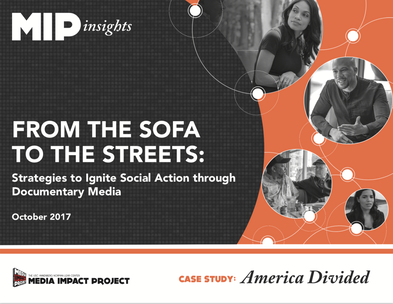 By Laurie Trotta Valenti A case study by the USC Annenberg Norman Lear Center’s Media Impact Project illustrates how one documentary series helped re-invigorate progressive groups following the 2016 elections, and may have lessons for media makers intent on social impact. The study of the EPIX series America Divided (which is available on Amazon and HULU) illustrates that documentarians can use innovative engagement campaigns to rally the public to action long after a program’s broadcast (if they were lucky enough to be broadcast!). America Divided producers took 10 strategic steps to engage citizens following broadcast. Some of the steps were tried and true, such as using celebrity prestige to attract attention, but others were innovative, such as editing several shorter, single-issue versions of the series that could be screened before niche groups. This helped to build coalitions around the project as well as re-energize a demoralized liberal base following the 2016 elections. The MIP study revealed that a key benefit was this re-invigoration of groups around the root causes of social injustice: the screenings and panel discussions gave activists a reason to assemble, to air their views and, more importantly, the paths to solutions. Specific actions that grew from these assemblages include canvassing, starting Social Media pages, creating petitions, signing-up for planned marches and rallies, as well as organizing additional meetings and screenings. The Case Study extracts 15 insights for media makers to create engagement around their work: 15 Tips for Media Makers to Keep Social Issues in the Public Eye 1. Think of broadcast as just the first step in your engagement campaign. 2. Forge partnerships with groups who can screen and promote your work. 3. Seek connections between your issue and any arts, civic, philanthropy or cultural groups and their own activist work. 4. Focus screening campaigns around one rallying issue. 5. Partner with regional PR firms that know the local players and issues and can unite disparate groups. 6. Be open to re-purposing edits that allow for issue or region specific coalitions. 7. Exploit celebrity power to cross-promote online, draw live audiences and create a relevant “face” for the issue. 8. Use screenings as forums for people to assemble, discuss and create community. 9. Engage audiences in panel discussions following screenings to promote deeper dialogue and create plans for social action. 10. Support learning with fact-based resources for deeper study. 11. Keep the momentum going by continuing to supply content to your partner groups. 12. Reach out to different-minded audiences to promote civil discourse. 13. Make the information in your documentary searchable online 14. Make certain screening partners can easily access your materials. 15. Keep your website current so that it becomes a source for news on your issues, and maintain ongoing dialogue with your digital audience. Here is a full copy of the report; please contact us at if you would like to be added to our mailing list. ### Comments are closed.
|
AuthorWrite something about yourself. No need to be fancy, just an overview. Archives
December 2023
Categories
All
|

 RSS Feed
RSS Feed